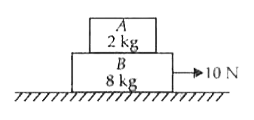To set a body mass 5 kg in motion over a horizontal surface a minimum force of 30 N has to be applied. What is the value of the coefficient of friction?Solution in Bengali
Force of limiting friction, f = 30N, weight of the body mg = 5×9.8= 49 N
Normal force R by the plane.
∴ R = mg =49 N
Hence μ=fR=3049= 0.612.
Topper's Solved these Questions
- BOOK - CHHAYA PUBLICATIONCHAPTER - FRICTION EXERCISE - Section Related Questions9videos
FRICTION
- BOOK - CHHAYA PUBLICATIONCHAPTER - FRICTION EXERCISE - HIGHER ORDER THINKING SKILL ( HOTS ) QUESTIONS14videos
FRICTION
- BOOK - CHHAYA PUBLICATIONCHAPTER - FIRST AND SECOND LAW OF THERMODYNAMICSEXERCISE - CBSE SCANNER18videos
FIRST AND SECOND LAW OF THERMODYNAMICS
- BOOK - CHHAYA PUBLICATIONCHAPTER - HYDROSTATICSEXERCISE - CBSE SCANNER1videos
HYDROSTATICS
Similar Questions
What is friction? What is the origin of friction?
03:52View SolutionWhy should one take short footsteps while walking on ice ( or oily surface ) ?
05:47View SolutionWrite the second law of thermodynamics.
02:42View SolutionUsing Pascal's law, explain with a neat figure, the working of a hydraulic lift. Mention any one situation from your daily life where hydrostatic paradox is useful.
03:46View SolutionA body of mass 2 kg at rest on a horizontal table. The coefficient of friction between the body and the table is 0.3 . A force of 5N is applied on the body. The force of friction is
05:27View SolutionA block weighing 20 N rests on a horizontal surface. The: coefficient of static friction between block and surface is 0.40 and the coefficient of kinetic friction is 0.20. ( a) How large is the friction force exerted on the block? (b) How great will the friction force be if a horizontal force of 5 N is exerted on the block? (c) What is the minimum force that will start the block in motion? (d) What is the minimum force that will keep the block in motion once it has been started? (e) If the horizontal force is 10 N, what is the friction force?
03:46View SolutionWhat is the minimum force that needs to be applied on a body of mass 100 g, kept on a horizontal surface, to set the body in motion? Given, coefficient of friction between the surface and the body is 0.4 and the force acts parallel to the surface.
View SolutionBlock A of mass 2 kg is placed over block B of mass 8 kg .The combination is placed over a rough horizonatal surface .Cofficient of friction between B and the floor is 0.5 .Coefficient of friction berween A and B is 0.4 .A horizontal force of 10 N is applied on block B .The force of friction between A and B is
(g=10 ms−2)
 03:30View Solution
03:30View SolutionA body of 2 kg is placed on a frictionless horizontal plane with a horizontal plane 30^(@) Will be the value of the friction force applied to the body.
04:26View SolutionA body of weight 20N is on a horizontal surface, minimum force applied to pull it when applied force makes an angle 60° with horizontal (angle of friction a = 30°) is
View SolutionA body of weight 20N is on a horizontal surface, minimum force applied to pull it when applied force makes an angle 60^(@) with horizontal (angle of friction a = 30^(@) ) is
View SolutionA body of weight 20N is on a horizontal surface, minimum force applied to pull it when applied force makes an angle 60∘ with horizontal (angle of friction θ=30∘) is
02:03View SolutionA body of mass M is kept on a rough horizontal surface (friction coefficient =μ). A person is trying to pull the body by applying a horizontal force but the body is not moving. The force by the horizontal surface on the surface of the body is F, where
02:00View SolutionA body of weight 20N is on a horizontal surface, minimum force applied to pull it when applied force makes an angle 60∘ with horizontal (angle of friction a=30∘) is
03:32View SolutionA block of mass 20 kg is placed on a rough horizontal plane and a horizontal force of 12 N is applied. If coefficient of friction is 0.1 the frictional force acting on it is,
03:35View Solution

